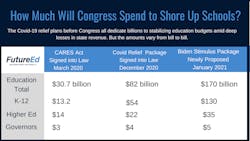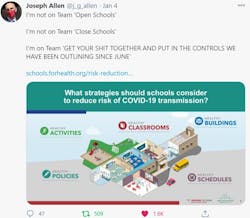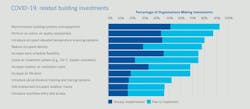School IAQ Rehabs Poised to Lead Mid-Year Turnaround
Among the flurry of new pandemic-related Executive Orders issued by President Biden in his first week in office, this one may have the most immediate impact on our industry:
- Supporting the Reopening and Continuing Operation of Schools and Early Childhood Education Providers -- It directs a national strategy for safely reopening schools, including requiring the Departments of Education and HHS to provide guidance on safe reopening and operating, and to develop a Safer Schools and Campuses Best Practices Clearinghouse to share lessons learned and best practices from across the country. GOAL: Getting a majority of K-8 schools safely open in 100 days.
Yes, schools are a big part of the new, national, '100 Days' Strategy, and whether or not this ambitious initial goal is achieved, one thing seems certain. School ventilation upgrades will dominate the 2021 education construction market as never before.
Already, the $900-billion federal stimulus bill that was signed into law in December had set aside $54 billion in funding for K-12 school projects and $22 billion for colleges and universities. Most of those funds were expected to be poured into HVAC work to improve indoor air quality enough to allow public schools safely to welcome back more socially distanced students into their buildings, as soon as possible. Now, the Biden Administration's new proposed stimulus package would more than double those allotments, adding another $130 million for K-12 schools, and $35 billion for higher education. And those funds would go well beyond bricks and mortar projects.
- "The Administration will release a handbook that helps schools and local leaders implement the precautions and strategies necessary for safe reopening. It will also work with states and local school districts to support screening testing in schools, including working with states to ensure an adequate supply of test kits."
As more and more COVID vaccinations increase across the U.S., particularly among teachers and school staff, it now seems that there is genuine cause for optimism, even as the grim news continues in our nation's hospitals. Schools have been a particular point of contention in the last year, as administrators, teachers, parents, custodians, unions, and politicians have clashed repeatedly, often with valid health and safety concerns on multiple sides of multiple issues.
And not surprisingly, IAQ experts have been drawn into the controversy, as well. Indeed, Dr. Joseph Allen, Harvard University's leading expert on healthy buildings Tweeted this blunt message earlier this month:
For its part, ASHRAE's Epidemic Task Force has been even more immersed in the debate, determined to let the science lead decision-making. HPAC Engineering advisory board member Dr. William Bahnfleth, P.E., an architectural engineering professor at Penn State University, has led the task force since it was formed last spring. On K-12 schools, he has expressed concern for the psychological toll of facility shutdowns on students forced into remote learning, but he has been equally adamant about the need to create safe buildings.
Toward that end, the Task Force's updated recommendations for schools can be found here.
In a recent webinar hosted by IAQ specialists enVerid Systems, Bahnfleth said, "ASHRAE's Core Recommendations are based on an equivalent clean air supply approach that allows the effects of filters, air cleaners other removal mechanisms to be added together to achieve an exposure reduction target."
Reviewing the current crop of economic prospects for the U.S. education construction market, the latest American Institute of Architects Consensus Industry Forecast was released Jan. 13. Aggregating the eight forecasting firms that it follows, AIA's consensus outlook expects a 3.9% decline in the roughly $100-billion market for school construction contracts this year, before a rebound of 2.7% in 2022. Admittedly, all predictions were made before any new Biden Stimulus package has been enacted. So passage of that legislation in some form this spring should boost those numbers.
Among the eight economists included, Moody's Analytics is the most optimistic about 2021, forecasting $104.6 billion in school construction contracts this year, up 4.8 % over 2020. And Moody's sees another 5.6% increase slated for 2022. On the flip side, Wells Fargo Securities is by far the most pessimistic in the group, predicting that education work will slip 12% this year to $97 billion, before recovering mildly in 2022 with an expected gain of 2.5%.
"As we move into 2021, we do expect that the economy will recover, and it will move in lockstep with the vaccine rollout," said Richard Branch, Chief Economist for Dodge Data & Analytics. For its part, Dodge Data has been predicting a 5% decline for education work this year, with a 1.4% rebound set for 2022.
In November, Johnson Controls surveyed 100 facility executives at K-12 schools across the U.S. as part of its new OpenBlue Healthy Buildings initiative. The report found that 21% had already used prior federal economic stimulus funds from last spring to help pay for building improvements. Overall, air treatments and ventilation represented the top COVID-19 building investments.
"Industry, trade, and public health organizations have recommended various changes to buildings to help control the spread of the virus," said the report. "In addition to increasing work schedule flexibility and reducing occupancy density, more than half of organizations have performed indoor air quality assessments, introduced elevated temperature scanning systems, and increased air filtration."
Again, as this recovery year progresses, and the virus deals us likely setbacks along the way, look for more school HVAC renovation activity to grow exponentially into the summer. Frustrated stakeholders from every corner will be determined to make the 2021-22 school year that starts next fall as normal as possible in the post-COVID-19 era.
And HVACR engineers will be absolutely essential to creating that reality.
##########
This report is the first in HPAC Engineering's new monthly online series on key markets in our industry.
Next month: Office construction.
##########
About the Author
Rob McManamy
Editor in Chief
An industry reporter and editor since 1987, McManamy joined HPAC Engineering in September 2017, after three years with BuiltWorlds.com, a Chicago-based media startup focused on tech innovation in the built environment. He has been covering design and construction issues for more than 30 years, having started at Engineering News-Record (ENR) in New York, before becoming its Midwest Bureau Chief in 1990. In 1998, McManamy was named Editor-in-Chief of Design-Build magazine, where he served for four years. He subsequently worked as an editor and freelance writer for Building Design + Construction and Public Works magazines.
A native of Bronx, NY, he is a graduate of both the University of Virginia, and The John Marshall Law School in Chicago.
Contact him at [email protected].



